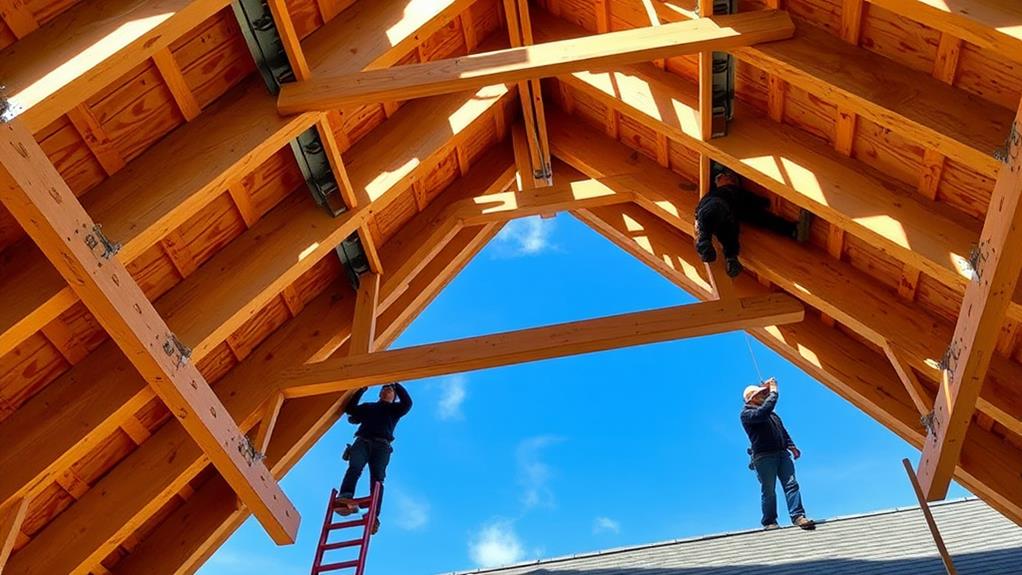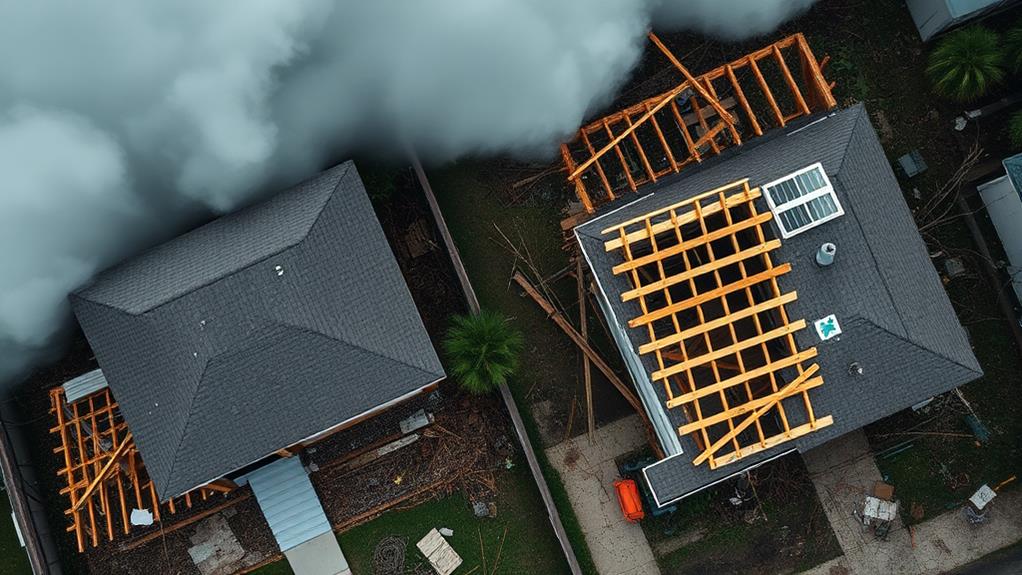Roof trusses are engineered structures that form the backbone of a home's roofing system, providing strength and stability against hurricane forces. These triangular designs distribute loads evenly, resisting uplift and lateral pressures generated by high winds. Properly installed trusses, secured with hurricane straps and adequate bracing, significantly enhance a roof's ability to withstand severe storms. Homeowners should ensure their trusses meet local building codes and consider retrofitting options for older homes. Regular inspections and maintenance are crucial in hurricane-prone areas. Understanding truss performance and implementing appropriate reinforcement measures can greatly improve a home's resilience against nature's most powerful storms.
Understanding Roof Truss Basics

Roof trusses serve as the backbone of a building's roofing system, bearing the weight of the roof and distributing it evenly across the structure. These engineered components are typically made from wood or metal and consist of a series of triangular units. The triangular design provides exceptional strength and stability, allowing trusses to span large distances without the need for interior support walls.
Key elements of a roof truss include the top chord, bottom chord, and web members. The top chord forms the roof's slope, while the bottom chord acts as the ceiling joist. Web members connect these chords, creating the truss's distinctive shape. Trusses come in various styles, such as common, scissor, and hip trusses, each designed for specific architectural needs.
Compared to traditional stick framing, roof trusses offer several advantages. They're cost-effective, quick to install, and provide consistent quality. Trusses also allow for greater design flexibility and can accommodate complex roof shapes. Understanding these basics is crucial for homeowners considering roof repairs or replacements, especially in hurricane-prone areas where structural integrity is paramount.
Common Truss Designs
Building upon the fundamentals of roof truss construction, it's important to examine the most prevalent truss designs used in residential and commercial structures. The most common types include the King Post, Queen Post, Fink, Howe, and Warren trusses.
King Post trusses, characterized by a central vertical post, are simple and effective for small spans. Queen Post trusses, an extension of the King Post design, incorporate two vertical posts and are suitable for medium spans.
Fink trusses, also known as Common trusses, feature a series of diagonal web members and are widely used in residential construction due to their versatility and cost-effectiveness.
Howe trusses, distinguished by vertical web members in compression and diagonal members in tension, are often employed in bridges and industrial buildings. Warren trusses, recognized by their equilateral triangle pattern, provide excellent stability and are frequently used in both residential and commercial applications.
Each truss design offers unique advantages in terms of load distribution, span capabilities, and material efficiency. The selection of an appropriate truss design depends on factors such as building size, roof pitch, local climate conditions, and architectural preferences.
Hurricane Forces on Roofs

When hurricane-force winds batter a structure, the roof bears the brunt of their destructive power. Hurricanes exert complex forces on roofs, including uplift, lateral pressure, and impact from wind-borne debris.
The primary threat is uplift, where strong winds passing over the roof create a low-pressure area above it, similar to an airplane wing. This low pressure, combined with high pressure under the roof from wind entering the building, can generate significant upward force.
Lateral forces push against the roof's vertical surfaces, potentially causing racking or twisting. These forces are particularly dangerous for gable roofs, which present a large surface area to the wind. Wind-borne debris can puncture roofing materials, compromising the structure's integrity and allowing water intrusion.
The magnitude of these forces increases exponentially with wind speed. For example, a 125 mph wind exerts four times the pressure of a 62 mph wind. Roof shape, pitch, and overhang design significantly influence a roof's vulnerability to hurricane forces. Hip roofs typically perform better than gable roofs due to their aerodynamic shape and reduced surface area exposed to wind.
Truss Performance in Storms
Given the immense forces hurricanes exert on roofs, the structural integrity of roof trusses becomes paramount. Well-designed and properly installed trusses can significantly enhance a roof's ability to withstand hurricane-force winds and flying debris. Engineered trusses, typically constructed from wood or metal, distribute loads evenly across the roof structure, reducing stress on individual components.
During high winds, trusses work in tandem with other roof elements to resist uplift forces. The triangular design of trusses provides inherent stability, while their interconnected nature allows for load sharing across the entire roof system. However, the performance of trusses in storms depends on several factors, including material quality, construction methods, and connection strength.
Critical to truss performance is the use of hurricane straps or clips, which secure the trusses to the wall structure. These metal fasteners significantly improve the roof's resistance to wind uplift. Additionally, proper bracing within the truss system prevents lateral movement and maintains structural integrity during violent storms. Regular inspections and maintenance of trusses, especially in hurricane-prone areas, are essential to ensure optimal performance when severe weather strikes.
Strengthening Existing Trusses

For homeowners in hurricane-prone regions, strengthening existing roof trusses can significantly enhance a structure's resilience against severe storms. Several proven methods can reinforce trusses without requiring a complete roof replacement.
One effective approach involves installing hurricane straps or clips, which secure the trusses to the top plates of walls, preventing uplift during high winds. These metal connectors distribute the load more evenly and create a continuous load path from the roof to the foundation.
Another strategy is to add lateral bracing between trusses, reducing their tendency to twist or buckle under extreme pressure. Gusset plates, which are flat metal pieces fastened to truss joints, can strengthen weak points and improve overall structural integrity. For older homes, retrofitting with additional support beams or collar ties can provide extra reinforcement.
Sealing the roof deck with a secondary water barrier and using ring-shank nails for sheathing attachment further fortifies the roof system. Professional assessment is crucial to determine the most appropriate strengthening measures for each unique situation, ensuring that modifications comply with local building codes and do not compromise the truss design's original load-bearing capacity.
Building Codes and Regulations
Building codes and regulations play a pivotal role in ensuring roof trusses can withstand hurricane-force winds. These standards are continually updated to reflect the latest engineering knowledge and lessons learned from previous storms. In hurricane-prone regions, local building codes often exceed national standards, requiring more robust truss designs and connections.
Key aspects of hurricane-resistant building codes for roof trusses include:
- Wind load requirements: Trusses must be designed to withstand specific wind speeds based on geographical location.
- Uplift resistance: Codes specify minimum requirements for truss-to-wall connections to prevent roof separation.
- Bracing and support: Regulations dictate proper truss bracing and support to maintain structural integrity during high winds.
- Material specifications: Codes outline approved materials and fasteners for truss construction.
- Inspection and certification: Many jurisdictions require professional inspection and certification of truss installations.
Homeowners should familiarize themselves with local building codes and ensure their contractors adhere to these standards. Compliance not only enhances safety but may also be required for insurance coverage and can increase property value. Regular code updates mean that older homes may benefit from truss retrofits to meet current standards.
Choosing Hurricane-Resistant Trusses

When selecting roof trusses for hurricane-prone areas, homeowners and builders must prioritize designs that offer superior wind resistance and structural integrity. Key factors to consider include truss configuration, materials, and connection methods.
Triangular or Fink trusses are popular choices due to their inherent stability and ability to distribute loads effectively. These designs minimize uplift forces during high winds. Parallel chord trusses, while less common, can also provide excellent hurricane resistance when properly engineered.
Material selection is crucial. Galvanized steel trusses offer exceptional strength-to-weight ratios and corrosion resistance, making them ideal for coastal regions. High-grade lumber, such as Southern Yellow Pine or Douglas Fir, treated with preservatives, can also withstand harsh conditions.
Robust connections are vital for truss performance during hurricanes. Hurricane clips, straps, and ties should be used to secure trusses to wall plates and other structural components. Engineered metal plates at truss joints enhance overall stability.
Consulting with a structural engineer or truss manufacturer specializing in hurricane-resistant designs is essential. They can provide customized solutions based on local wind zone requirements, building codes, and specific architectural needs, ensuring optimal protection against hurricane forces.
Frequently Asked Questions
Can I Install Solar Panels on a Roof With Hurricane-Resistant Trusses?
Yes, you can install solar panels on a roof with hurricane-resistant trusses. However, it's crucial to consult with a professional solar installer and structural engineer to ensure proper installation and maintain the roof's integrity and hurricane resistance.
How Often Should Roof Trusses Be Inspected for Potential Hurricane Damage?
Roof trusses should be inspected annually, and after any major storm event. Professional inspections are recommended every 3-5 years. Regular visual checks by homeowners can help identify potential issues between formal inspections. Immediate assessment is crucial following hurricane exposure.
Are Metal Roof Trusses More Hurricane-Resistant Than Wooden Ones?
Metal roof trusses generally offer superior hurricane resistance compared to wooden trusses. They provide greater strength, durability, and resistance to wind uplift. However, proper design, installation, and maintenance are crucial for optimal performance regardless of material choice.
Do Hurricane-Resistant Roof Trusses Affect Home Insurance Premiums?
Like a financial safety net, hurricane-resistant roof trusses can indeed impact home insurance premiums. Insurance companies often offer discounts for homes with reinforced structures, recognizing the reduced risk of damage during severe weather events. This can lead to lower rates.
Can Retrofitting Existing Trusses Match the Performance of Newly Built Hurricane-Resistant Ones?
Retrofitting existing trusses can significantly improve hurricane resistance, but may not fully match the performance of newly built hurricane-resistant trusses. Proper engineering and installation are crucial for effectiveness. Consult a structural engineer for optimal results.
Conclusion
As hurricanes rage and winds howl, the humble roof truss stands as a critical line of defense. Proper design, construction, and reinforcement of trusses can mean the difference between shelter and devastation. While building codes evolve and technologies advance, nature's fury remains constant. Homeowners must navigate this delicate balance, weighing cost against safety, tradition against innovation. In the end, a well-engineered truss system offers peace of mind amidst the storm's chaos.

